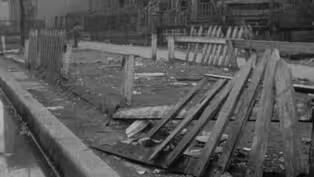Great Migrations: A People on The Move
The 1967 Detroit Uprising
Clip: Episode 3 | 2m 38sVideo has Closed Captions
The 1967 Detroit uprising was one of the most violent of the 20th century.
The 1967 Detroit uprising was one of the most violent of the 20th century, and it was rooted in a series of grievances, first and foremost, persistent police harassment.
Problems playing video? | Closed Captioning Feedback
Problems playing video? | Closed Captioning Feedback
Corporate support for GREAT MIGRATIONS: A PEOPLE ON THE MOVE is provided by Bank of America, Ford Motor Company and Johnson & Johnson. Major support is provided by the Corporation...
Great Migrations: A People on The Move
The 1967 Detroit Uprising
Clip: Episode 3 | 2m 38sVideo has Closed Captions
The 1967 Detroit uprising was one of the most violent of the 20th century, and it was rooted in a series of grievances, first and foremost, persistent police harassment.
Problems playing video? | Closed Captioning Feedback
How to Watch Great Migrations: A People on The Move
Great Migrations: A People on The Move is available to stream on pbs.org and the free PBS App, available on iPhone, Apple TV, Android TV, Android smartphones, Amazon Fire TV, Amazon Fire Tablet, Roku, Samsung Smart TV, and Vizio.
Buy Now
Providing Support for PBS.org
Learn Moreabout PBS online sponsorshipBy the 1960s, Detroit was a tinderbox.
There was growing discontent around housing, at the city's economy, about the lack of opportunity, about overcrowded schools.
But one of the most important issues that played out in Detroit in that period was the persistence of police harassment and violence targeting African Americans.
One evening in July, 1967, those tensions boiled over.
July 23rd, on a hot summer night, there was a party.
The celebrations went on into the wee hours of the morning, and the Detroit police came to break it up.
They raid the place expecting to arrest 15, 20 people like they always getting these kinds of raids, but it's 85 people there.
Folks began to gather to see what the commotion was and soon took to the streets, breaking windows and lighting fires.
Soon, the uprising in Detroit spread, passed the black neighborhood on the west side to cover ultimately close to a hundred square miles of the city.
The National Guard was called in.
The National Guard.
They're young white men from small towns who've never really seen black people in real life.
They have military style weapons, but they're about as trained as Boy Scouts.
You put them in the middle of a rebellion/riot with angry black people, they answer it the only way they know how, by shooting them.
After five days of unrest, 43 people had been killed, more than a thousand had been injured, and over 2,500 buildings had been looted or burned.
The tragedy of 1967 was the huge number of deaths.
The majority of those 43 people who died, died at the hands of law enforcement officials.
Detroit was one of the most violent uprisings in the 20th century.
It was a collective expression of grievance, of frustration and discontent.
How the Housing Crisis Impacted the Great Migration
Video has Closed Captions
Clip: Ep3 | 4m 29s | Housing had always been inadequate in the Northern Black neighborhoods of the Great Migration. (4m 29s)
Providing Support for PBS.org
Learn Moreabout PBS online sponsorshipSupport for PBS provided by:
Corporate support for GREAT MIGRATIONS: A PEOPLE ON THE MOVE is provided by Bank of America, Ford Motor Company and Johnson & Johnson. Major support is provided by the Corporation...
















